Health issues and nursing care in poor health-facility zone of Australia
VerifiedAdded on 2022/11/13
|9
|2458
|123
AI Summary
This article discusses the health issues and nursing care in poor health-facility zone of Australia. It highlights the impact of food-price policies on the health of the needy and how these policies need to be developed to improve health-condition in this area. It also discusses how social isolation can lead to mental health disorder and what kind of health issues the rural people might face that can require professional involvement.
Contribute Materials
Your contribution can guide someone’s learning journey. Share your
documents today.
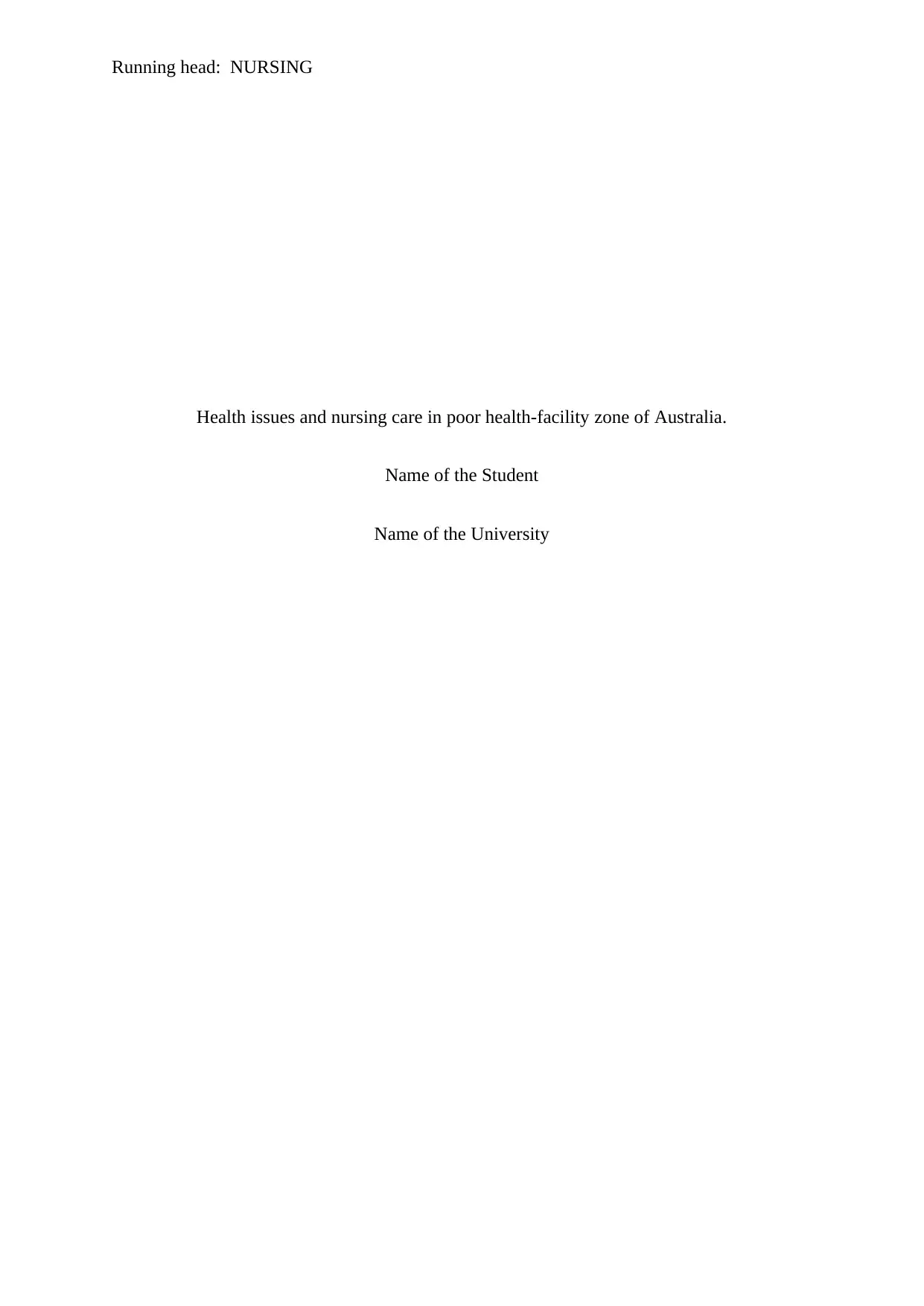
Running head: NURSING
Health issues and nursing care in poor health-facility zone of Australia.
Name of the Student
Name of the University
Health issues and nursing care in poor health-facility zone of Australia.
Name of the Student
Name of the University
Secure Best Marks with AI Grader
Need help grading? Try our AI Grader for instant feedback on your assignments.

1
NURSING
Part 1
According to Ferguson et al. (2018), (https://www.mdpi.com/1660-4601/15/12/2908)
Aboriginal and Torres Strait Islander population are exposed to the poorest facility of health
due to diet-related issues. He highlights the fact that costs of store-foods is high in these
remote zones whereas the income of people is low, which leads to a range of health issues
and poverty. The researchers revealed that the food price was extremely high which was not
affordable for local poor people. This led to the development of food-related chronic diseases
in the area. They suggested that the food-price policies had basic shortcomings and were not
effective enough and did not include all strata of the population, and hence poor people
suffered vehemently. So, hereby it will be discussed how these policies affect the health of
the needy and how these food-price policies need to be developed to improve health-
condition in this area.
The community stores have to implement a decision effective enough for the policy
developmental process. Authors suggested that almost all essential healthy food products like
vegetables, fish, and milk had prices equal to the urban areas. The research conducted
investigated the prices of all daily groceries along with carbonated, sweetened beverages.
Investigators suggest that effective schemes can be developed concerning the price of food,
where prices of the daily food items are reduced for better accessibility to people, and the
price of carbonated beverages does not need to be altered as they are unhealthy in nature and
do not add to the daily food value. Accessibility of food and they are sustainable or not
should be taken into account during policy development. Another most important factor is the
nutrition value of the food that must be emphasized. Emphasis on these aspects must be given
while developing strategies, so that poor people also get access to these articles and improve
their health condition (Ferguson et al. 2018).
NURSING
Part 1
According to Ferguson et al. (2018), (https://www.mdpi.com/1660-4601/15/12/2908)
Aboriginal and Torres Strait Islander population are exposed to the poorest facility of health
due to diet-related issues. He highlights the fact that costs of store-foods is high in these
remote zones whereas the income of people is low, which leads to a range of health issues
and poverty. The researchers revealed that the food price was extremely high which was not
affordable for local poor people. This led to the development of food-related chronic diseases
in the area. They suggested that the food-price policies had basic shortcomings and were not
effective enough and did not include all strata of the population, and hence poor people
suffered vehemently. So, hereby it will be discussed how these policies affect the health of
the needy and how these food-price policies need to be developed to improve health-
condition in this area.
The community stores have to implement a decision effective enough for the policy
developmental process. Authors suggested that almost all essential healthy food products like
vegetables, fish, and milk had prices equal to the urban areas. The research conducted
investigated the prices of all daily groceries along with carbonated, sweetened beverages.
Investigators suggest that effective schemes can be developed concerning the price of food,
where prices of the daily food items are reduced for better accessibility to people, and the
price of carbonated beverages does not need to be altered as they are unhealthy in nature and
do not add to the daily food value. Accessibility of food and they are sustainable or not
should be taken into account during policy development. Another most important factor is the
nutrition value of the food that must be emphasized. Emphasis on these aspects must be given
while developing strategies, so that poor people also get access to these articles and improve
their health condition (Ferguson et al. 2018).

2
NURSING
Temple, Kelaher and Paradies (2019), (https://www.ncbi.nlm.nih.gov/pubmed/31230607)
focussed on mental health disorders in the indigenous population of older Aboriginal and
Torres Strait Islander people caused by racism that prevails in the indigenous zone. The
survey revealed that distinction was common in the older population of the community
especially in people above 45 years old. They suggested that it is important to control the
factors that promote social discrimination. It was observed that in certain demographic
population these exclusion prevails much more. People experiencing distinct treatments and
avoidance are 3.3 times more disposed to psychological distress than those who have not
(95% CI =2.17, 5.13). People who have only experienced unfair behaviour are twice more
disposed than normal people and those who have faced only avoidance are 2.5 times more
exposed to psychological distress compared to normal people. Hereby, they discussed how
social isolation can lead to the mental health disorder.
Social distress, cultural, religious and ethnic, religious distinctions can lead to a
diverse array of health issues. It consisted of ill-development of one’s cognitive abilities and
can hamper physically and emotionally. These can lead to reduced physical activities, stress,
and addiction to habits like smoking, drinking and, drugs. Hence, it can lead to psychological
suffering as well as physical even oral health conditions. It can lead to depression, anxiety,
insomnia, and social isolation. These findings suggest the issue that effective health care
systems and health conditions are not available because of racism and financial status and the
minority of the population. So, social services, old-age agencies, health care facilities must
take urgent actions in this regard. This study throws limelight on how with a decrease in
social stature the racism, isolation caused by people is amplified and how psychological
condition and physical health worsens in such cases (Temple, Kelaher & Paradies, 2019).
NURSING
Temple, Kelaher and Paradies (2019), (https://www.ncbi.nlm.nih.gov/pubmed/31230607)
focussed on mental health disorders in the indigenous population of older Aboriginal and
Torres Strait Islander people caused by racism that prevails in the indigenous zone. The
survey revealed that distinction was common in the older population of the community
especially in people above 45 years old. They suggested that it is important to control the
factors that promote social discrimination. It was observed that in certain demographic
population these exclusion prevails much more. People experiencing distinct treatments and
avoidance are 3.3 times more disposed to psychological distress than those who have not
(95% CI =2.17, 5.13). People who have only experienced unfair behaviour are twice more
disposed than normal people and those who have faced only avoidance are 2.5 times more
exposed to psychological distress compared to normal people. Hereby, they discussed how
social isolation can lead to the mental health disorder.
Social distress, cultural, religious and ethnic, religious distinctions can lead to a
diverse array of health issues. It consisted of ill-development of one’s cognitive abilities and
can hamper physically and emotionally. These can lead to reduced physical activities, stress,
and addiction to habits like smoking, drinking and, drugs. Hence, it can lead to psychological
suffering as well as physical even oral health conditions. It can lead to depression, anxiety,
insomnia, and social isolation. These findings suggest the issue that effective health care
systems and health conditions are not available because of racism and financial status and the
minority of the population. So, social services, old-age agencies, health care facilities must
take urgent actions in this regard. This study throws limelight on how with a decrease in
social stature the racism, isolation caused by people is amplified and how psychological
condition and physical health worsens in such cases (Temple, Kelaher & Paradies, 2019).
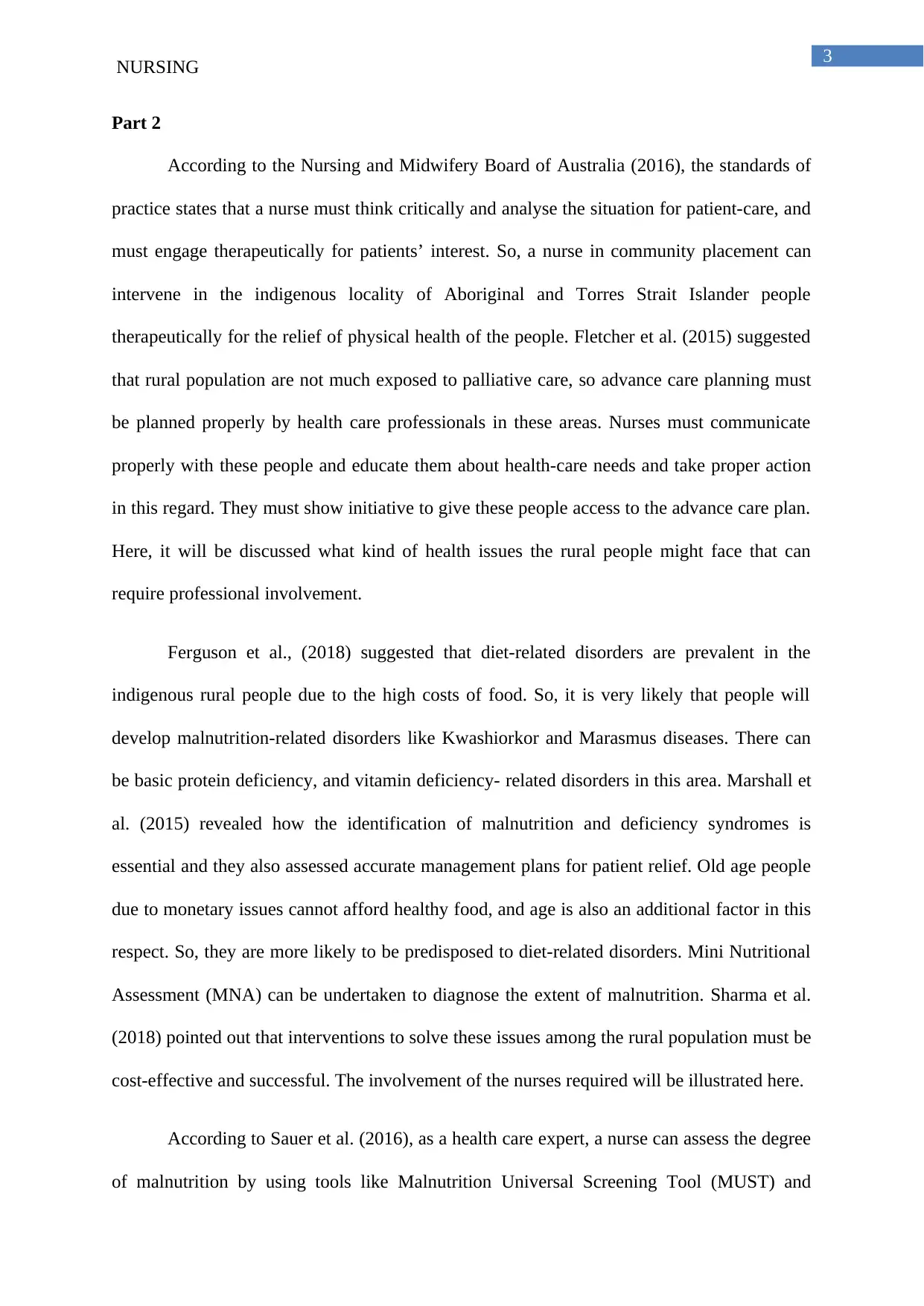
3
NURSING
Part 2
According to the Nursing and Midwifery Board of Australia (2016), the standards of
practice states that a nurse must think critically and analyse the situation for patient-care, and
must engage therapeutically for patients’ interest. So, a nurse in community placement can
intervene in the indigenous locality of Aboriginal and Torres Strait Islander people
therapeutically for the relief of physical health of the people. Fletcher et al. (2015) suggested
that rural population are not much exposed to palliative care, so advance care planning must
be planned properly by health care professionals in these areas. Nurses must communicate
properly with these people and educate them about health-care needs and take proper action
in this regard. They must show initiative to give these people access to the advance care plan.
Here, it will be discussed what kind of health issues the rural people might face that can
require professional involvement.
Ferguson et al., (2018) suggested that diet-related disorders are prevalent in the
indigenous rural people due to the high costs of food. So, it is very likely that people will
develop malnutrition-related disorders like Kwashiorkor and Marasmus diseases. There can
be basic protein deficiency, and vitamin deficiency- related disorders in this area. Marshall et
al. (2015) revealed how the identification of malnutrition and deficiency syndromes is
essential and they also assessed accurate management plans for patient relief. Old age people
due to monetary issues cannot afford healthy food, and age is also an additional factor in this
respect. So, they are more likely to be predisposed to diet-related disorders. Mini Nutritional
Assessment (MNA) can be undertaken to diagnose the extent of malnutrition. Sharma et al.
(2018) pointed out that interventions to solve these issues among the rural population must be
cost-effective and successful. The involvement of the nurses required will be illustrated here.
According to Sauer et al. (2016), as a health care expert, a nurse can assess the degree
of malnutrition by using tools like Malnutrition Universal Screening Tool (MUST) and
NURSING
Part 2
According to the Nursing and Midwifery Board of Australia (2016), the standards of
practice states that a nurse must think critically and analyse the situation for patient-care, and
must engage therapeutically for patients’ interest. So, a nurse in community placement can
intervene in the indigenous locality of Aboriginal and Torres Strait Islander people
therapeutically for the relief of physical health of the people. Fletcher et al. (2015) suggested
that rural population are not much exposed to palliative care, so advance care planning must
be planned properly by health care professionals in these areas. Nurses must communicate
properly with these people and educate them about health-care needs and take proper action
in this regard. They must show initiative to give these people access to the advance care plan.
Here, it will be discussed what kind of health issues the rural people might face that can
require professional involvement.
Ferguson et al., (2018) suggested that diet-related disorders are prevalent in the
indigenous rural people due to the high costs of food. So, it is very likely that people will
develop malnutrition-related disorders like Kwashiorkor and Marasmus diseases. There can
be basic protein deficiency, and vitamin deficiency- related disorders in this area. Marshall et
al. (2015) revealed how the identification of malnutrition and deficiency syndromes is
essential and they also assessed accurate management plans for patient relief. Old age people
due to monetary issues cannot afford healthy food, and age is also an additional factor in this
respect. So, they are more likely to be predisposed to diet-related disorders. Mini Nutritional
Assessment (MNA) can be undertaken to diagnose the extent of malnutrition. Sharma et al.
(2018) pointed out that interventions to solve these issues among the rural population must be
cost-effective and successful. The involvement of the nurses required will be illustrated here.
According to Sauer et al. (2016), as a health care expert, a nurse can assess the degree
of malnutrition by using tools like Malnutrition Universal Screening Tool (MUST) and
Secure Best Marks with AI Grader
Need help grading? Try our AI Grader for instant feedback on your assignments.
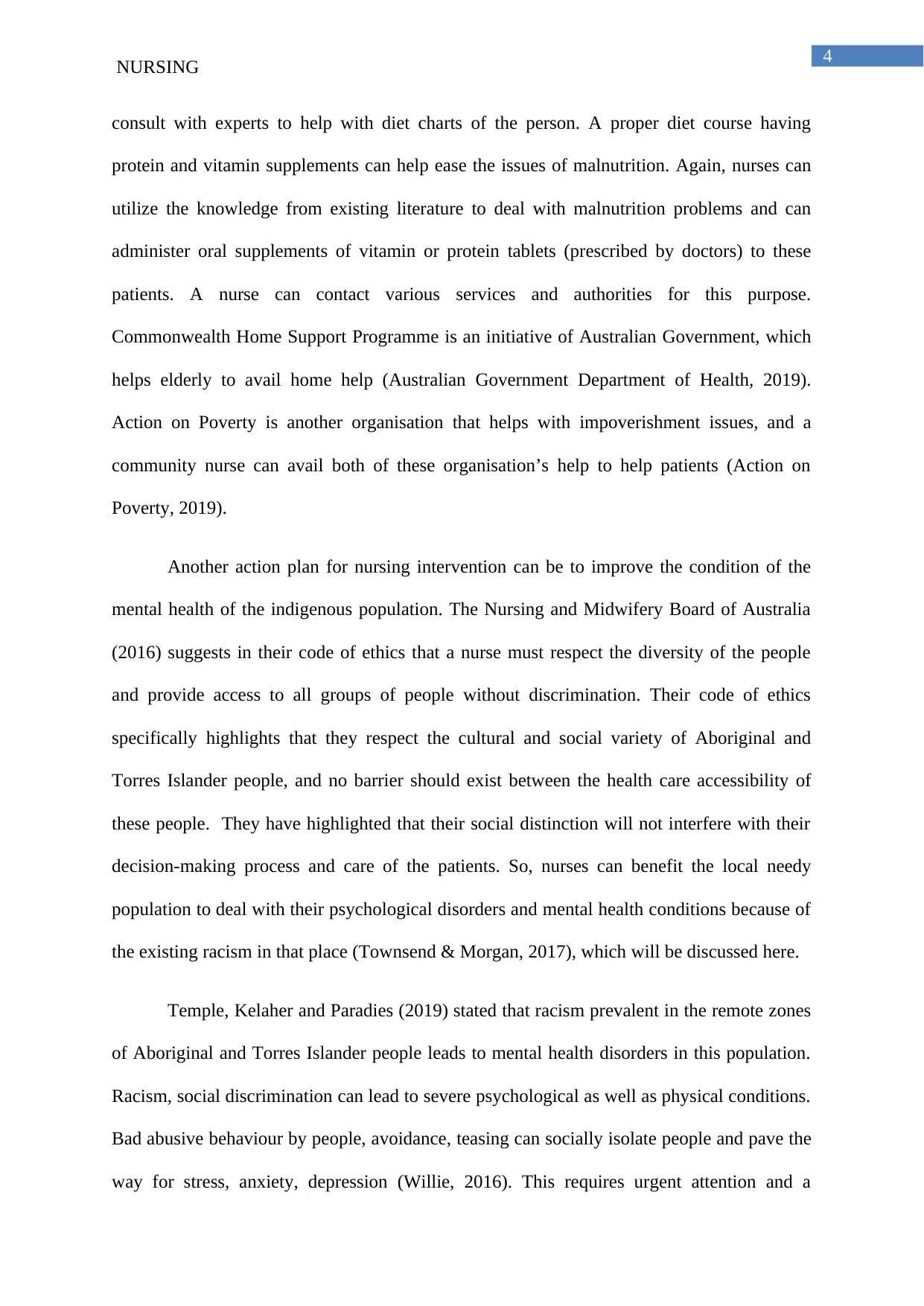
4
NURSING
consult with experts to help with diet charts of the person. A proper diet course having
protein and vitamin supplements can help ease the issues of malnutrition. Again, nurses can
utilize the knowledge from existing literature to deal with malnutrition problems and can
administer oral supplements of vitamin or protein tablets (prescribed by doctors) to these
patients. A nurse can contact various services and authorities for this purpose.
Commonwealth Home Support Programme is an initiative of Australian Government, which
helps elderly to avail home help (Australian Government Department of Health, 2019).
Action on Poverty is another organisation that helps with impoverishment issues, and a
community nurse can avail both of these organisation’s help to help patients (Action on
Poverty, 2019).
Another action plan for nursing intervention can be to improve the condition of the
mental health of the indigenous population. The Nursing and Midwifery Board of Australia
(2016) suggests in their code of ethics that a nurse must respect the diversity of the people
and provide access to all groups of people without discrimination. Their code of ethics
specifically highlights that they respect the cultural and social variety of Aboriginal and
Torres Islander people, and no barrier should exist between the health care accessibility of
these people. They have highlighted that their social distinction will not interfere with their
decision-making process and care of the patients. So, nurses can benefit the local needy
population to deal with their psychological disorders and mental health conditions because of
the existing racism in that place (Townsend & Morgan, 2017), which will be discussed here.
Temple, Kelaher and Paradies (2019) stated that racism prevalent in the remote zones
of Aboriginal and Torres Islander people leads to mental health disorders in this population.
Racism, social discrimination can lead to severe psychological as well as physical conditions.
Bad abusive behaviour by people, avoidance, teasing can socially isolate people and pave the
way for stress, anxiety, depression (Willie, 2016). This requires urgent attention and a
NURSING
consult with experts to help with diet charts of the person. A proper diet course having
protein and vitamin supplements can help ease the issues of malnutrition. Again, nurses can
utilize the knowledge from existing literature to deal with malnutrition problems and can
administer oral supplements of vitamin or protein tablets (prescribed by doctors) to these
patients. A nurse can contact various services and authorities for this purpose.
Commonwealth Home Support Programme is an initiative of Australian Government, which
helps elderly to avail home help (Australian Government Department of Health, 2019).
Action on Poverty is another organisation that helps with impoverishment issues, and a
community nurse can avail both of these organisation’s help to help patients (Action on
Poverty, 2019).
Another action plan for nursing intervention can be to improve the condition of the
mental health of the indigenous population. The Nursing and Midwifery Board of Australia
(2016) suggests in their code of ethics that a nurse must respect the diversity of the people
and provide access to all groups of people without discrimination. Their code of ethics
specifically highlights that they respect the cultural and social variety of Aboriginal and
Torres Islander people, and no barrier should exist between the health care accessibility of
these people. They have highlighted that their social distinction will not interfere with their
decision-making process and care of the patients. So, nurses can benefit the local needy
population to deal with their psychological disorders and mental health conditions because of
the existing racism in that place (Townsend & Morgan, 2017), which will be discussed here.
Temple, Kelaher and Paradies (2019) stated that racism prevalent in the remote zones
of Aboriginal and Torres Islander people leads to mental health disorders in this population.
Racism, social discrimination can lead to severe psychological as well as physical conditions.
Bad abusive behaviour by people, avoidance, teasing can socially isolate people and pave the
way for stress, anxiety, depression (Willie, 2016). This requires urgent attention and a
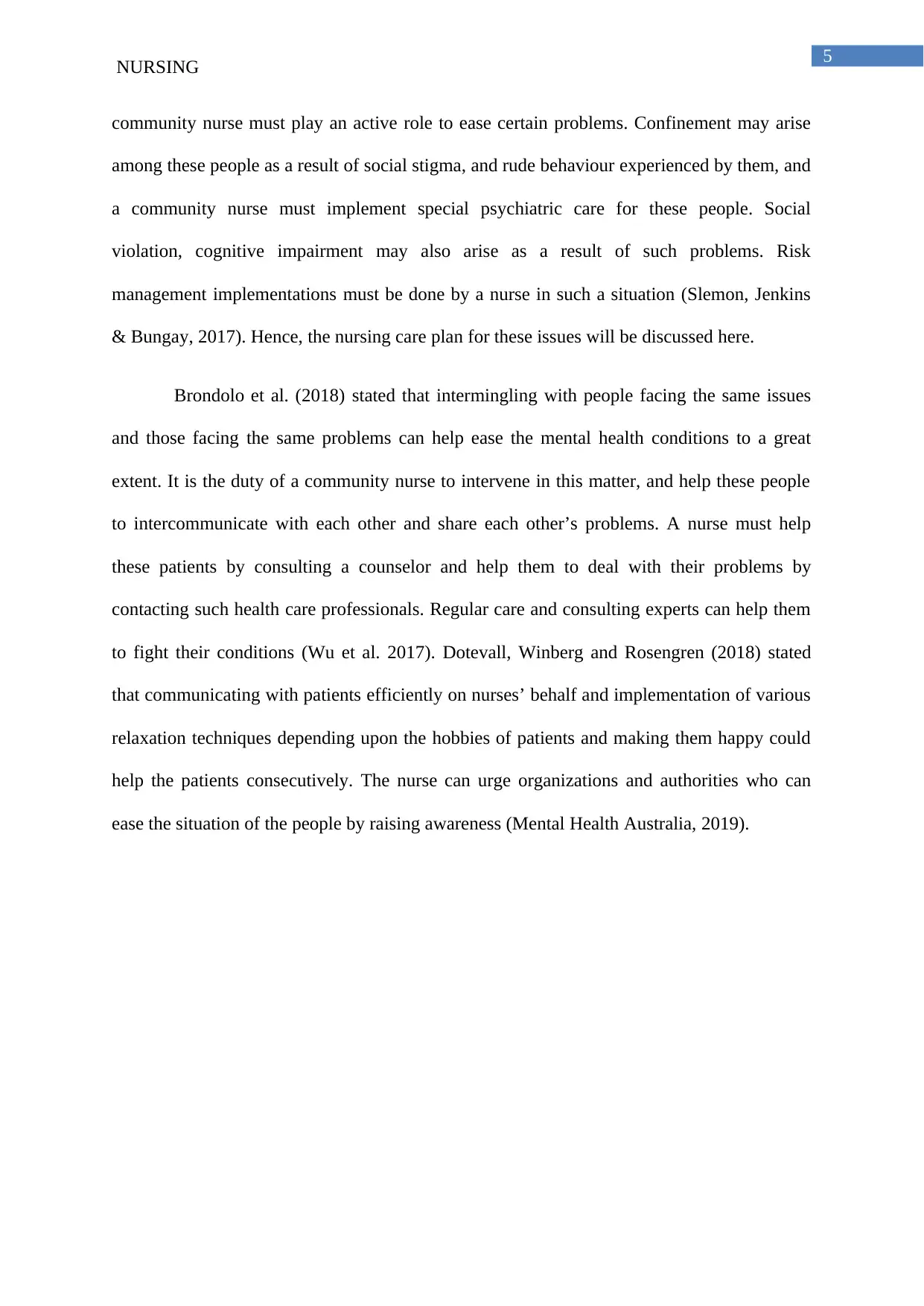
5
NURSING
community nurse must play an active role to ease certain problems. Confinement may arise
among these people as a result of social stigma, and rude behaviour experienced by them, and
a community nurse must implement special psychiatric care for these people. Social
violation, cognitive impairment may also arise as a result of such problems. Risk
management implementations must be done by a nurse in such a situation (Slemon, Jenkins
& Bungay, 2017). Hence, the nursing care plan for these issues will be discussed here.
Brondolo et al. (2018) stated that intermingling with people facing the same issues
and those facing the same problems can help ease the mental health conditions to a great
extent. It is the duty of a community nurse to intervene in this matter, and help these people
to intercommunicate with each other and share each other’s problems. A nurse must help
these patients by consulting a counselor and help them to deal with their problems by
contacting such health care professionals. Regular care and consulting experts can help them
to fight their conditions (Wu et al. 2017). Dotevall, Winberg and Rosengren (2018) stated
that communicating with patients efficiently on nurses’ behalf and implementation of various
relaxation techniques depending upon the hobbies of patients and making them happy could
help the patients consecutively. The nurse can urge organizations and authorities who can
ease the situation of the people by raising awareness (Mental Health Australia, 2019).
NURSING
community nurse must play an active role to ease certain problems. Confinement may arise
among these people as a result of social stigma, and rude behaviour experienced by them, and
a community nurse must implement special psychiatric care for these people. Social
violation, cognitive impairment may also arise as a result of such problems. Risk
management implementations must be done by a nurse in such a situation (Slemon, Jenkins
& Bungay, 2017). Hence, the nursing care plan for these issues will be discussed here.
Brondolo et al. (2018) stated that intermingling with people facing the same issues
and those facing the same problems can help ease the mental health conditions to a great
extent. It is the duty of a community nurse to intervene in this matter, and help these people
to intercommunicate with each other and share each other’s problems. A nurse must help
these patients by consulting a counselor and help them to deal with their problems by
contacting such health care professionals. Regular care and consulting experts can help them
to fight their conditions (Wu et al. 2017). Dotevall, Winberg and Rosengren (2018) stated
that communicating with patients efficiently on nurses’ behalf and implementation of various
relaxation techniques depending upon the hobbies of patients and making them happy could
help the patients consecutively. The nurse can urge organizations and authorities who can
ease the situation of the people by raising awareness (Mental Health Australia, 2019).

6
NURSING
References
Action on Poverty. (2019). Health. Access date: 20th July, 2019. [Online] Retrieved from:
https://actiononpoverty.org/our-programs/health/
Australian Government Department of Health. (2019). Aging and Aged Care Service. Access
date: 20th July 2019. [Online]. Retrieved from: https://agedcare.health.gov.au/older-
people-their-families-and-carers/staying-at-home/help-to-stay-at-home
Brondolo, E., Ng, W., Pierre, K. L. J., & Lane, R. (2016). Racism and mental health:
Examining the link between racism and depression from a social cognitive
perspective.
Dotevall, C., Winberg, E., & Rosengren, K. (2018). Nursing students' experiences with
refugees with mental health problems in Jordan: A qualitative content analysis. Nurse
education today, 61, 155-161.
Ferguson, M., O'dea, K., Altman, J., Moodie, M., & Brimblecombe, J. (2018). Health-
promoting food pricing policies and decision-making in very remote Aboriginal and
Torres Strait Islander community stores in Australia. International journal of
environmental research and public health, 15(12), 2908.
Fletcher, S., Sinclair, C., Rhee, J., Goh, D., & Auret, K. (2016). Rural health professionals’
experiences in implementing advance care planning: a focus group study. Australian
journal of primary health, 22(5), 423-427.
Marshall, S., Young, A., Bauer, J., & Isenring, E. (2016). Malnutrition in geriatric
rehabilitation: prevalence, patient outcomes, and criterion validity of the scored
NURSING
References
Action on Poverty. (2019). Health. Access date: 20th July, 2019. [Online] Retrieved from:
https://actiononpoverty.org/our-programs/health/
Australian Government Department of Health. (2019). Aging and Aged Care Service. Access
date: 20th July 2019. [Online]. Retrieved from: https://agedcare.health.gov.au/older-
people-their-families-and-carers/staying-at-home/help-to-stay-at-home
Brondolo, E., Ng, W., Pierre, K. L. J., & Lane, R. (2016). Racism and mental health:
Examining the link between racism and depression from a social cognitive
perspective.
Dotevall, C., Winberg, E., & Rosengren, K. (2018). Nursing students' experiences with
refugees with mental health problems in Jordan: A qualitative content analysis. Nurse
education today, 61, 155-161.
Ferguson, M., O'dea, K., Altman, J., Moodie, M., & Brimblecombe, J. (2018). Health-
promoting food pricing policies and decision-making in very remote Aboriginal and
Torres Strait Islander community stores in Australia. International journal of
environmental research and public health, 15(12), 2908.
Fletcher, S., Sinclair, C., Rhee, J., Goh, D., & Auret, K. (2016). Rural health professionals’
experiences in implementing advance care planning: a focus group study. Australian
journal of primary health, 22(5), 423-427.
Marshall, S., Young, A., Bauer, J., & Isenring, E. (2016). Malnutrition in geriatric
rehabilitation: prevalence, patient outcomes, and criterion validity of the scored
Paraphrase This Document
Need a fresh take? Get an instant paraphrase of this document with our AI Paraphraser
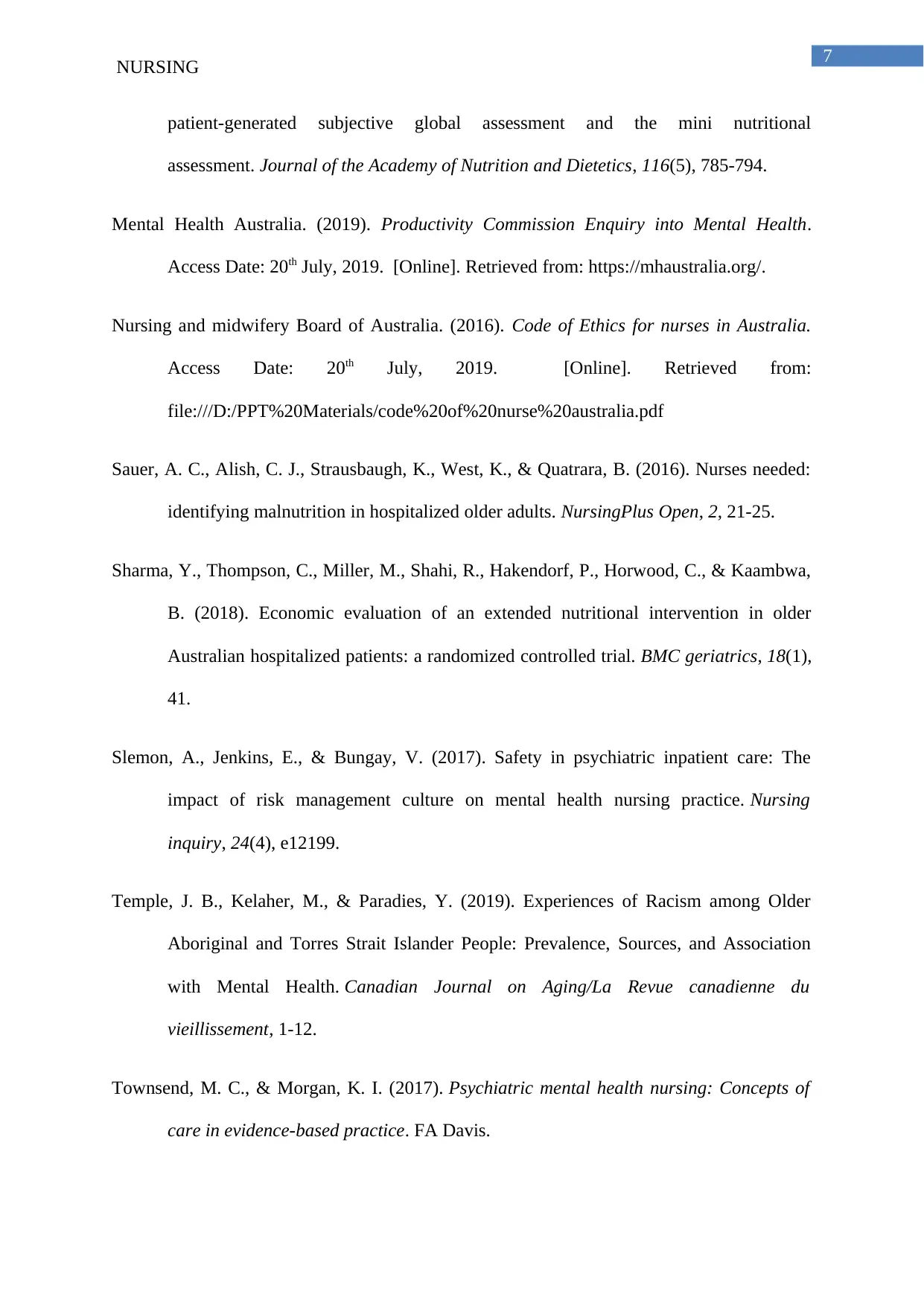
7
NURSING
patient-generated subjective global assessment and the mini nutritional
assessment. Journal of the Academy of Nutrition and Dietetics, 116(5), 785-794.
Mental Health Australia. (2019). Productivity Commission Enquiry into Mental Health.
Access Date: 20th July, 2019. [Online]. Retrieved from: https://mhaustralia.org/.
Nursing and midwifery Board of Australia. (2016). Code of Ethics for nurses in Australia.
Access Date: 20th July, 2019. [Online]. Retrieved from:
file:///D:/PPT%20Materials/code%20of%20nurse%20australia.pdf
Sauer, A. C., Alish, C. J., Strausbaugh, K., West, K., & Quatrara, B. (2016). Nurses needed:
identifying malnutrition in hospitalized older adults. NursingPlus Open, 2, 21-25.
Sharma, Y., Thompson, C., Miller, M., Shahi, R., Hakendorf, P., Horwood, C., & Kaambwa,
B. (2018). Economic evaluation of an extended nutritional intervention in older
Australian hospitalized patients: a randomized controlled trial. BMC geriatrics, 18(1),
41.
Slemon, A., Jenkins, E., & Bungay, V. (2017). Safety in psychiatric inpatient care: The
impact of risk management culture on mental health nursing practice. Nursing
inquiry, 24(4), e12199.
Temple, J. B., Kelaher, M., & Paradies, Y. (2019). Experiences of Racism among Older
Aboriginal and Torres Strait Islander People: Prevalence, Sources, and Association
with Mental Health. Canadian Journal on Aging/La Revue canadienne du
vieillissement, 1-12.
Townsend, M. C., & Morgan, K. I. (2017). Psychiatric mental health nursing: Concepts of
care in evidence-based practice. FA Davis.
NURSING
patient-generated subjective global assessment and the mini nutritional
assessment. Journal of the Academy of Nutrition and Dietetics, 116(5), 785-794.
Mental Health Australia. (2019). Productivity Commission Enquiry into Mental Health.
Access Date: 20th July, 2019. [Online]. Retrieved from: https://mhaustralia.org/.
Nursing and midwifery Board of Australia. (2016). Code of Ethics for nurses in Australia.
Access Date: 20th July, 2019. [Online]. Retrieved from:
file:///D:/PPT%20Materials/code%20of%20nurse%20australia.pdf
Sauer, A. C., Alish, C. J., Strausbaugh, K., West, K., & Quatrara, B. (2016). Nurses needed:
identifying malnutrition in hospitalized older adults. NursingPlus Open, 2, 21-25.
Sharma, Y., Thompson, C., Miller, M., Shahi, R., Hakendorf, P., Horwood, C., & Kaambwa,
B. (2018). Economic evaluation of an extended nutritional intervention in older
Australian hospitalized patients: a randomized controlled trial. BMC geriatrics, 18(1),
41.
Slemon, A., Jenkins, E., & Bungay, V. (2017). Safety in psychiatric inpatient care: The
impact of risk management culture on mental health nursing practice. Nursing
inquiry, 24(4), e12199.
Temple, J. B., Kelaher, M., & Paradies, Y. (2019). Experiences of Racism among Older
Aboriginal and Torres Strait Islander People: Prevalence, Sources, and Association
with Mental Health. Canadian Journal on Aging/La Revue canadienne du
vieillissement, 1-12.
Townsend, M. C., & Morgan, K. I. (2017). Psychiatric mental health nursing: Concepts of
care in evidence-based practice. FA Davis.
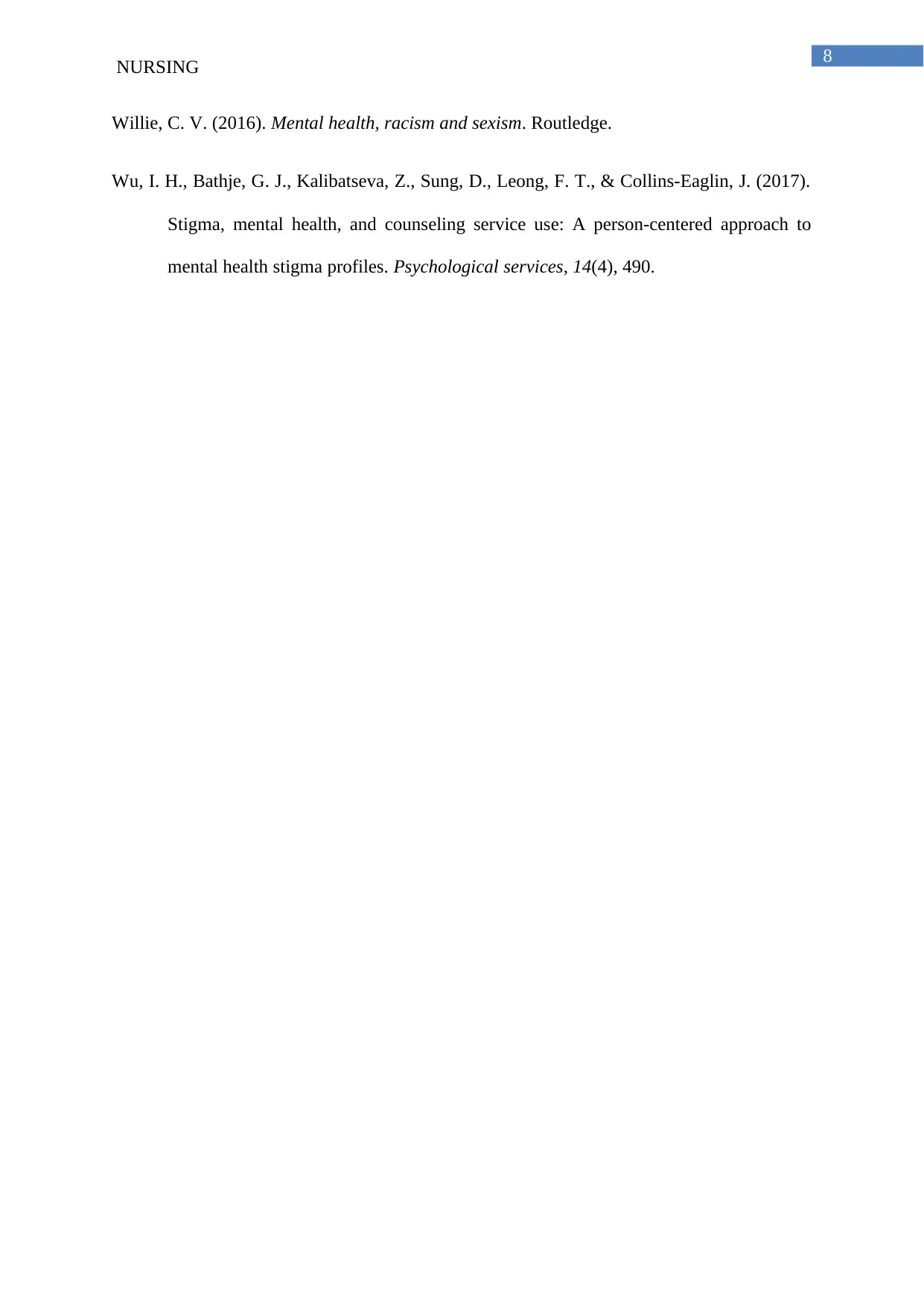
8
NURSING
Willie, C. V. (2016). Mental health, racism and sexism. Routledge.
Wu, I. H., Bathje, G. J., Kalibatseva, Z., Sung, D., Leong, F. T., & Collins-Eaglin, J. (2017).
Stigma, mental health, and counseling service use: A person-centered approach to
mental health stigma profiles. Psychological services, 14(4), 490.
NURSING
Willie, C. V. (2016). Mental health, racism and sexism. Routledge.
Wu, I. H., Bathje, G. J., Kalibatseva, Z., Sung, D., Leong, F. T., & Collins-Eaglin, J. (2017).
Stigma, mental health, and counseling service use: A person-centered approach to
mental health stigma profiles. Psychological services, 14(4), 490.
1 out of 9
Related Documents
Your All-in-One AI-Powered Toolkit for Academic Success.
+13062052269
info@desklib.com
Available 24*7 on WhatsApp / Email
![[object Object]](/_next/static/media/star-bottom.7253800d.svg)
Unlock your academic potential
© 2024 | Zucol Services PVT LTD | All rights reserved.





